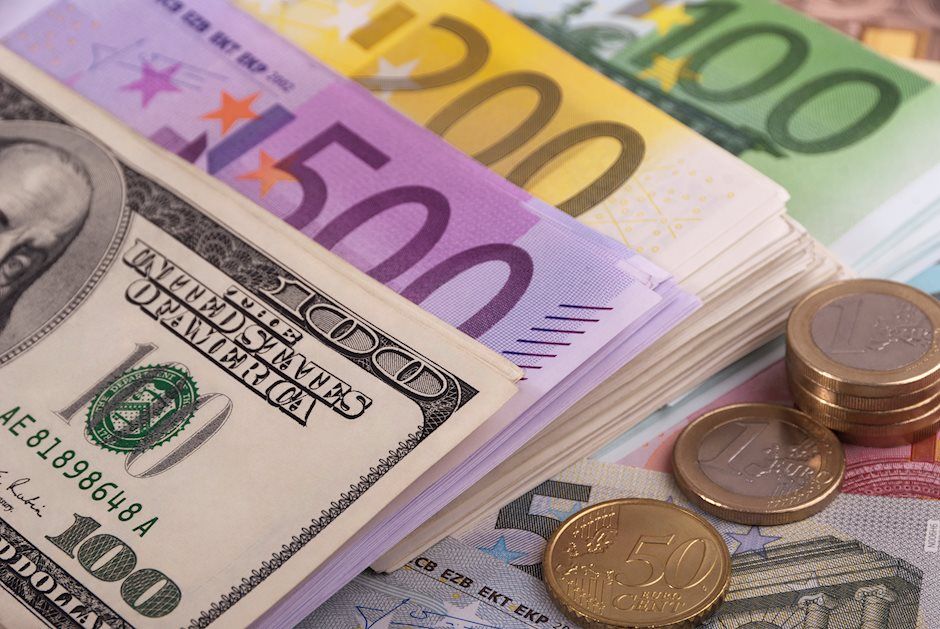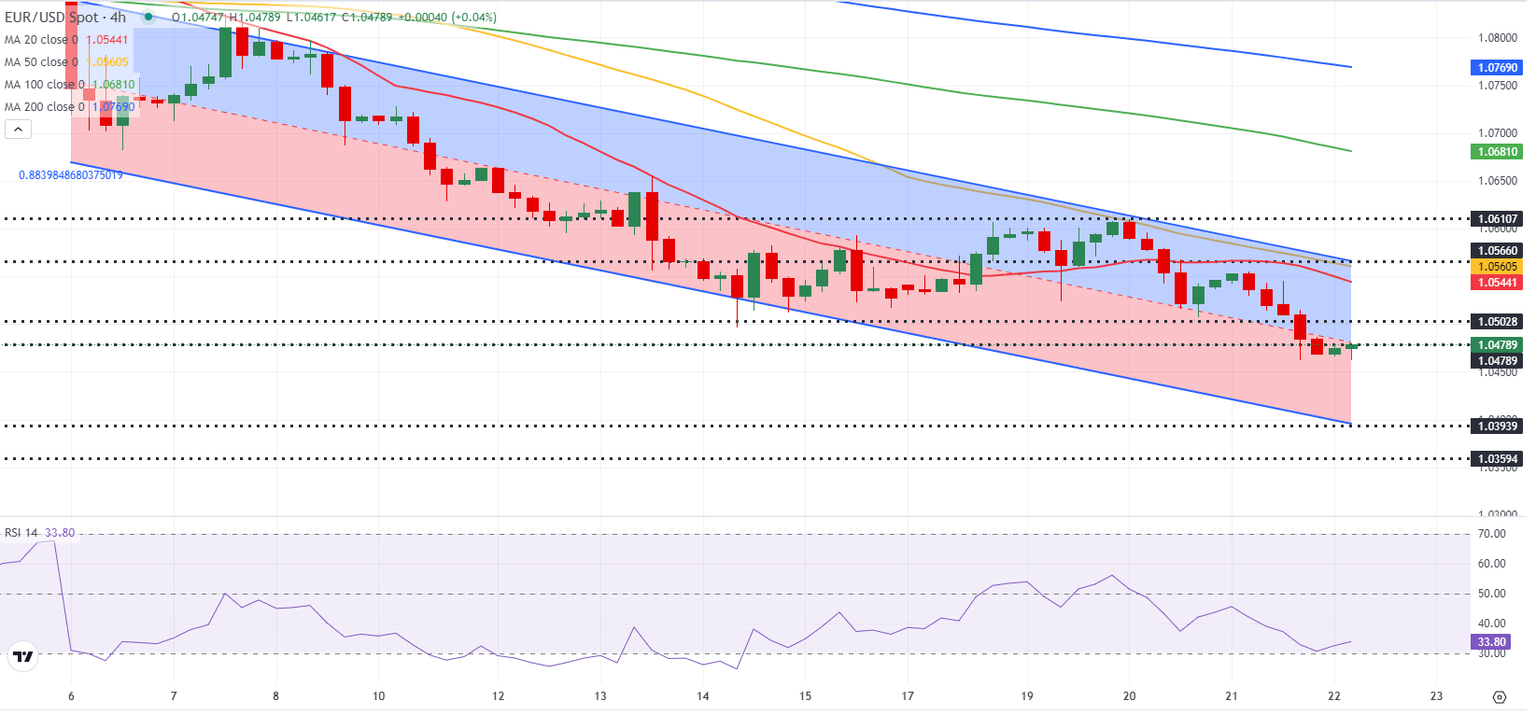EUR/USD Forecast: Sellers dominate ahead of key data releases
- EUR/USD trades at its lowest level in over a year below 1.0500.
- The technical outlook suggests that the pair is about to turn oversold.
- Investors await PMI data releases from Germany, the Eurozone and the US.

EUR/USD came under renewed bearish pressure in the American session on Thursday and touched its lowest level since October 2023 below 1.0500. The pair struggles to find a foothold early Friday as investors await key macroeconomic data releases.
Euro PRICE This week
The table below shows the percentage change of Euro (EUR) against listed major currencies this week. Euro was the weakest against the Canadian Dollar.
| USD | EUR | GBP | JPY | CAD | AUD | NZD | CHF | |
|---|---|---|---|---|---|---|---|---|
| USD | 0.59% | 0.40% | 0.37% | -0.81% | -0.61% | 0.49% | -0.19% | |
| EUR | -0.59% | -0.03% | -0.13% | -1.29% | -1.05% | 0.00% | -0.67% | |
| GBP | -0.40% | 0.03% | -0.08% | -1.26% | -1.02% | 0.04% | -0.64% | |
| JPY | -0.37% | 0.13% | 0.08% | -1.19% | -0.91% | 0.17% | -0.49% | |
| CAD | 0.81% | 1.29% | 1.26% | 1.19% | 0.23% | 1.31% | 0.63% | |
| AUD | 0.61% | 1.05% | 1.02% | 0.91% | -0.23% | 1.07% | 0.38% | |
| NZD | -0.49% | -0.01% | -0.04% | -0.17% | -1.31% | -1.07% | -0.67% | |
| CHF | 0.19% | 0.67% | 0.64% | 0.49% | -0.63% | -0.38% | 0.67% |
The heat map shows percentage changes of major currencies against each other. The base currency is picked from the left column, while the quote currency is picked from the top row. For example, if you pick the Euro from the left column and move along the horizontal line to the US Dollar, the percentage change displayed in the box will represent EUR (base)/USD (quote).
The US Dollar (USD) benefited from upbeat US data and hawkish comments from Federal Reserve (Fed) officials on Thursday, forcing EUR/USD to turn south in the second half of the day.
"Over the next year, it feels like rates will end up a fair bit lower than they are today," Chicago Fed President Austan Goolsbee said and argued that it may make sense to slow the pace of interest rate cuts as the Fed gets close to where rates will settle.
Preliminary November HCOB Manufacturing and Services Purchasing Managers Index (PMI) data from Germany and the Eurozone will be featured in the European economic calendar. In case Services PMI unexpectedly falls into the contraction territory below 50 either in Germany or the Eurozone, the immediate reaction could cause the Euro to weaken further against its major rivals.
Later in the day, S&P Global Manufacturing and Services PMI data for the US will be watched closely by market participants. If the Manufacturing PMI recovers above 50 and the Services PMI comes in near October's final print of 55, the USD could preserve its strength heading into the weekend and force EUR/USD to stretch lower.
EUR/USD Technical Analysis
EUR/USD trades near the mid-point of the descending regression channel and the Relative Strength Index (RSI) indicator on the 4-hour chart stays close to 30, suggesting that the pair could stage a technical correction before falling further.
On the upside, 1.0500 (former support, static level) aligns as first resistance before 1.0540 (20-period Simple Moving Average (SMA)) and 1.0570 (50-period SMA, upper limit of the descending channel). Looking south, supports could be spotted at 1.0400 (lower limit of the descending channel) and 1.0360 (static level from May 2023).
Euro FAQs
The Euro is the currency for the 19 European Union countries that belong to the Eurozone. It is the second most heavily traded currency in the world behind the US Dollar. In 2022, it accounted for 31% of all foreign exchange transactions, with an average daily turnover of over $2.2 trillion a day. EUR/USD is the most heavily traded currency pair in the world, accounting for an estimated 30% off all transactions, followed by EUR/JPY (4%), EUR/GBP (3%) and EUR/AUD (2%).
The European Central Bank (ECB) in Frankfurt, Germany, is the reserve bank for the Eurozone. The ECB sets interest rates and manages monetary policy. The ECB’s primary mandate is to maintain price stability, which means either controlling inflation or stimulating growth. Its primary tool is the raising or lowering of interest rates. Relatively high interest rates – or the expectation of higher rates – will usually benefit the Euro and vice versa. The ECB Governing Council makes monetary policy decisions at meetings held eight times a year. Decisions are made by heads of the Eurozone national banks and six permanent members, including the President of the ECB, Christine Lagarde.
Eurozone inflation data, measured by the Harmonized Index of Consumer Prices (HICP), is an important econometric for the Euro. If inflation rises more than expected, especially if above the ECB’s 2% target, it obliges the ECB to raise interest rates to bring it back under control. Relatively high interest rates compared to its counterparts will usually benefit the Euro, as it makes the region more attractive as a place for global investors to park their money.
Data releases gauge the health of the economy and can impact on the Euro. Indicators such as GDP, Manufacturing and Services PMIs, employment, and consumer sentiment surveys can all influence the direction of the single currency. A strong economy is good for the Euro. Not only does it attract more foreign investment but it may encourage the ECB to put up interest rates, which will directly strengthen the Euro. Otherwise, if economic data is weak, the Euro is likely to fall. Economic data for the four largest economies in the euro area (Germany, France, Italy and Spain) are especially significant, as they account for 75% of the Eurozone’s economy.
Another significant data release for the Euro is the Trade Balance. This indicator measures the difference between what a country earns from its exports and what it spends on imports over a given period. If a country produces highly sought after exports then its currency will gain in value purely from the extra demand created from foreign buyers seeking to purchase these goods. Therefore, a positive net Trade Balance strengthens a currency and vice versa for a negative balance.
Premium
You have reached your limit of 3 free articles for this month.
Start your subscription and get access to all our original articles.
Author

Eren Sengezer
FXStreet
As an economist at heart, Eren Sengezer specializes in the assessment of the short-term and long-term impacts of macroeconomic data, central bank policies and political developments on financial assets.


















